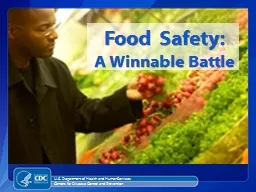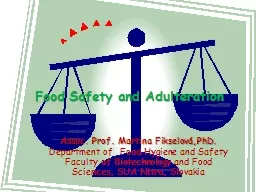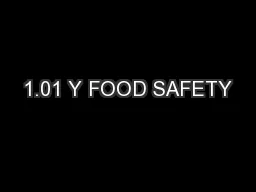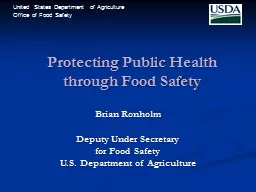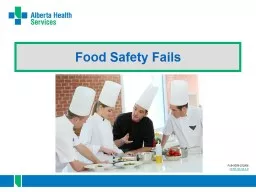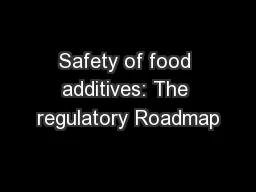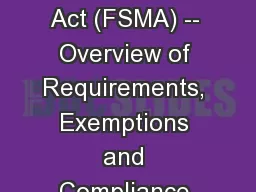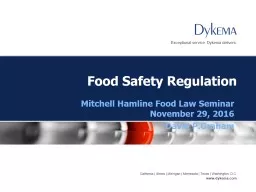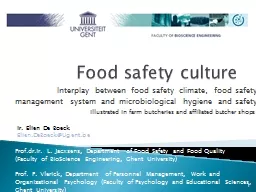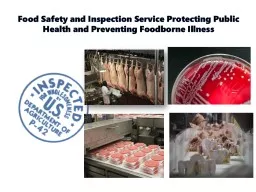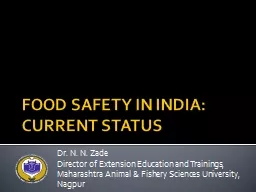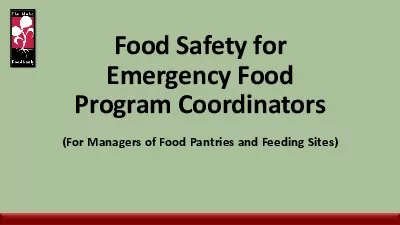PPT-Food Safety:
Author : ellena-manuel | Published Date : 2015-09-27
A Winnable Battle US Department of Health and Human Services Centers for Disease Control and Prevention Foodborne illness in the US Each year an estimated 1
Presentation Embed Code
Download Presentation
Download Presentation The PPT/PDF document "Food Safety:" is the property of its rightful owner. Permission is granted to download and print the materials on this website for personal, non-commercial use only, and to display it on your personal computer provided you do not modify the materials and that you retain all copyright notices contained in the materials. By downloading content from our website, you accept the terms of this agreement.
Food Safety:: Transcript
A Winnable Battle US Department of Health and Human Services Centers for Disease Control and Prevention Foodborne illness in the US Each year an estimated 1 in 6 Americans gets . Safety Break Safety Break Safety Break Safety Break Safety Break Safety Break Lap Swim (2) Open Swim (2) Lap Swim (2) 10:00am-4:25pm Open Swim (2) 12:10pm-2:30pm Safety Break Safety Break Safety Bre You will be given 10 seconds after each question before the slides advance to the answer page. To advance to next slide, press the space bar.. Kitchen and Food Safety. Name one group of individuals that are more susceptible to a food borne. and . Adulteration. Assoc. . Prof. Martina . Fikselová,PhD. .. Department . of. . Food. Hygiene and . Safety. Faculty. . of. . Biotechnology. and . Food. . Sciences. , SUA Nitra, Slovakia. Content. VS. FOOD SANITATION. 1. 1.01Y Food Sanitation vs. Food Safety. What’s the difference?. 1.01Y Food Sanitation vs. Food Safety. 2. 1.01Y Food Sanitation vs. Food Safety. Food Safety. Food safety is how food is handled to . Brian Ronholm. Deputy Under Secretary . for Food Safety. U.S. Department of Agriculture. Food Safety and Inspection Service (FSIS). Protects public health by ensuring the safety and proper labeling of the commercial meat, poultry, and processed egg products supply. CC BY-NC-SA 4.0. What is the food safety concern(s) in the picture?. Why is it a risk to the public?. How could the concern be fixed?. Food Safety Fails. Special Guest Appearances by Tom Cruise. Food Safety . 2017. . Keeping food safe is …. Food Safety . 2017. Ten Riskiest Foods Regulated by the FDA. A Warm-Up !. Ten Riskiest Foods Regulated by the FDA. Manojit Basu, PhD . Grocery Manufacturers Association (GMA). 1. Outline. GMA overview. Food Additives. Determining Regulatory . Status - FDA. Risk Assessment Process. FDA Safety Standards. 2. Grocery Manufacturers Association(GMA). Leslie T. . Krasny, Partner. Keller and Heckman . LLP. San Francisco Office. 415-948-2810. krasny@khlaw.com. Wine Institute – March 31, 2016. Food Safety Modernization Act (FSMA). This is the first in a series of three Wine Institute webinars regarding FSMA and other FDA requirements that may apply to wineries. . November 29, . 2016. David P.Graham. What Is Food Safety?. How do consumers view food . safety?. Increasing broad definition and long term risk view. clear and accurate labeling. clear information on ingredients and sourcing. Food safety culture Interplay between food safety climate, food safety management system and microbiological hygiene and safety ir. Elien De Boeck Elien.DeBoeck@Ugent.be Prof.dr.ir. L. Jacxsens Food Safety and Inspection Service Protecting Public Health and Preventing Foodborne Illness Food Safety an Inspection Service Financial Management Training Washington, D.C. July 9 , 2019 Cara LeConte STATUS. Dr. N. N. . Zade. Director of Extension Education and Trainings, . Maharashtra Animal & Fishery Sciences University, Nagpur . Food. "Food" means a raw, cooked, or processed edible substance, ice, beverage, or ingredient used or intended for use or for sale in whole or in part for human consumption, or chewing gum. Emergency Food Program CoordinatorsFor Managers of Food Pantries and Feeding SitesIntroductionFood Safety is the number ONEpriorityIt is the responsibility of IFB and Partner Agencies to provide the b
Download Document
Here is the link to download the presentation.
"Food Safety:"The content belongs to its owner. You may download and print it for personal use, without modification, and keep all copyright notices. By downloading, you agree to these terms.
Related Documents

